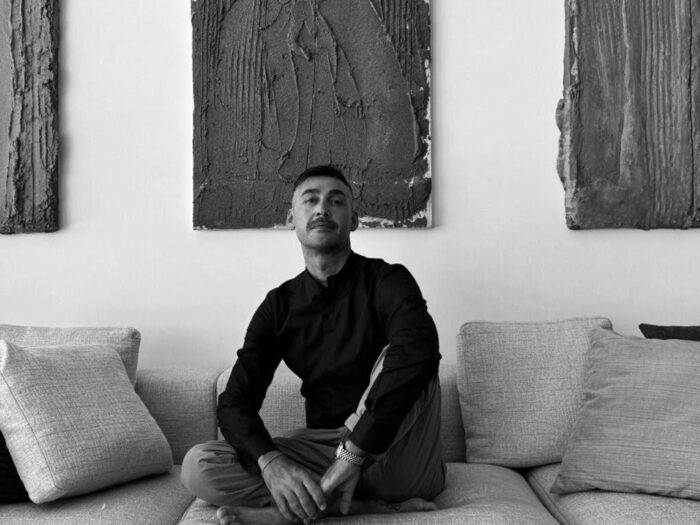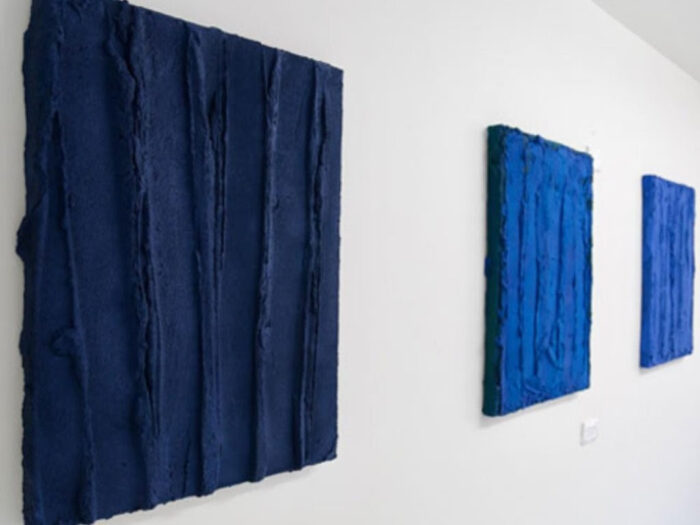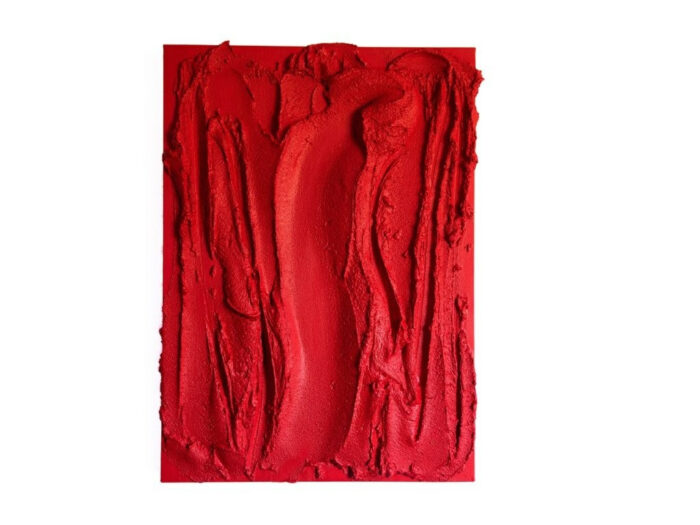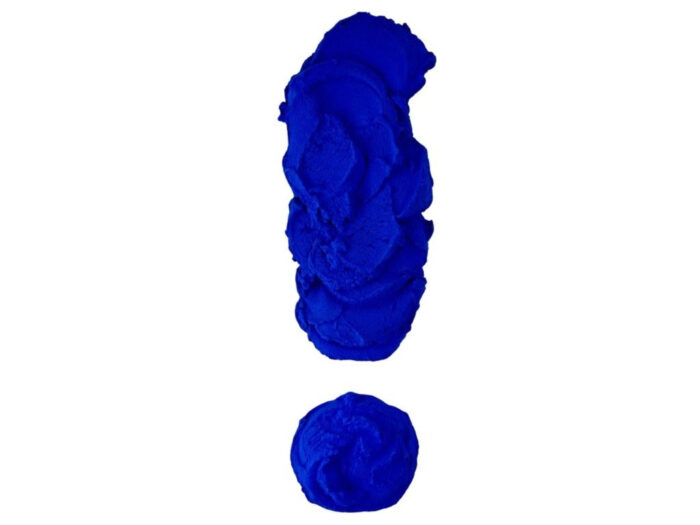Francesco Greco and the poetry of matter: from construction sites to the art of “Concrete”
 Francesco Greco didn’t begin his journey as an artist in the traditional sense. His roots lie in the world of construction: a realm that immediately became his source of inspiration. His father worked in interior finishing, a gifted plasterer with a rare artisanal mastery, combining precision with a refined sense of form. Beyond the allure of plaster, gypsum, and mortar that surrounded him in his father’s workshop, Greco deepened his relationship with materials through dental technology, his professional training, where resins and metals are meticulously crafted. Polymers turned into enamel and crowns, transforming from dust into a smile. Then came a spark, an artistic revelation ignited by a catastrophic earthquake: Alberto Burri’s Cretto di Gibellina, which unveiled for him another dimension of matter, its ability to become memory. Sicilian Secrets spoke with him about this journey.
Francesco Greco didn’t begin his journey as an artist in the traditional sense. His roots lie in the world of construction: a realm that immediately became his source of inspiration. His father worked in interior finishing, a gifted plasterer with a rare artisanal mastery, combining precision with a refined sense of form. Beyond the allure of plaster, gypsum, and mortar that surrounded him in his father’s workshop, Greco deepened his relationship with materials through dental technology, his professional training, where resins and metals are meticulously crafted. Polymers turned into enamel and crowns, transforming from dust into a smile. Then came a spark, an artistic revelation ignited by a catastrophic earthquake: Alberto Burri’s Cretto di Gibellina, which unveiled for him another dimension of matter, its ability to become memory. Sicilian Secrets spoke with him about this journey.
Q: Francesco, your background isn’t in art but in construction and dental technology. How has this “craft-based” path shaped your artistic vision and your relationship with materials?
A: Since I was very young, I’ve always been creative: I preferred drawing, coloring, and getting my hands messy rather than playing with toy cars or other games. As I grew up, that creativity grew with me, and I became increasingly aware of how much I loved creating with my hands. Mixing, blending, experimenting: yes, experimenting with whatever I could get my hands on. As a child, my father would take me to construction sites in the summer. I’d end up playing with mortar, spreading it over wooden boards or any surface I could find. Then, in September, I’d return to the lab and experiment with resins and plasters used in dental work. It was on those sites that a spark ignited: the desire to transform and give new life to matter, to turn it into emotion.
Just as a musician turns noise into sound, raw material becomes alive. After completing my studies, I began working in real estate, and once again, construction sites brought my past into the present, with my eyes on the future. A future defined by experimentation and an ever-deeper knowledge of materials. Finding balance between them, seeking transformation, and conveying emotion, not necessarily beautiful or ugly, just emotion, pure and simple.
Q: “Concrete” is the title of your exhibition, but also a statement of intent. What does it mean for you to make art “concrete”?
A: In my case, concreteness has several meanings. It’s about real transformation, something that takes form as “visual and emotional impact”. My works cannot go unnoticed; whether you like them or not, you can’t ignore them. They always provoke a reaction.

Q: In your work, matter itself takes center stage: resins, stucco, industrial pigments. What fascinates you most about working with such raw, “living” and imperfect materials?
A: I’m fascinated by the fact that I can create almost everything with my hands and fingers to sink into the material, to feel its texture and elasticity. When I close my eyes, what my skin perceives reaches my mind and my soul differently. I feel free. What I create is the result of a cerebral journey that floats, takes form, becomes substance and matter, matter that turns into language and, ultimately, expression.
Q: In the biography of Francesco Greco there’s a deep connection between you and Sicily, from Gela to Alcamo, and that “artistic spark” ignited by Burri’s Cretto. How does your homeland continue to inspire you, even now that you live between Lugano and Milan?
A: Even though I grew up mostly in Milan, I’ve always been deeply attached to this extraordinary land: sometimes I’ve dismissed it, cursed it, defended it… and today, more than ever, I’m madly in love with it. Words aren’t enough to describe my relationship with my island. But I can say it’s a constant source of inspiration: from the blue of the Mediterranean to the ancient Greek battles of eastern Sicily (Gela being one of the most important sites), to the awe I felt standing before Burri’s Cretto. A unique sensation: imagining what once was, and seeing an artwork that freezes time. When I was there, the silence was immense , yet that silence became sound, vibration, and emotion. A flood of inspiration.

Q: Art critic Massimiliano Reggiani has described you as “a chromatic sculptor, an aesthete of matter”. Do you identify with this definition? How would you describe your own artistic identity?
A: I do see myself in “aesthete of matter”. Or rather, a solitary wanderer, an aesthete of matter. I love exploring and, above all, experimenting. When I create, I become a wanderer in search of “beauty” and not only that. I could say that I don’t build walls or barriers; I build emotions you can touch.
Q: Among the most symbolic works in “Concrete” is Exclamation Point, accompanied by powerful words: “I free the soul from matter. The surface is silent, the gesture speaks.” What does this piece represent for you, and how was it born?
A: It was born from the need to extract the essence of the material emerging from my works, to give it a “backbone”, a soul. And I did. But it wasn’t enough, something inside me was still seeking answers. That’s when I created Exclamation Point. I can share that the full work is titled “…! “, the ellipsis followed by the exclamation point. The dots speak of what’s unresolved, while the exclamation point symbolizes everything else. That’s how language itself is born, the phrase becomes expression.

Q: In “Concrete”, you move through worlds that span from the Mediterranean to the forest, from the city to meditations on identity. Is there an invisible thread that ties all these dimensions together?
A: Absolutely. It’s the journey of the solitary wanderer, the aesthete of matter, who carries and shares with the viewer an invisible thread linking the sea of Sicily, my homeland of emotional conflict; the city that formed and raised me, Milan; and Switzerland – the place of reflection, transformation, and long walks through the woods.
Q: Looking ahead, after “Concrete”, what artistic directions do you feel drawn to explore? Do you already have an idea for your next project or exhibition?
A: Yes, I can reveal that I’m thinking and dreaming a lot about a new project. It fascinates me, provokes me, challenges me. It’s a further evolution…and I’ll keep experimenting!
